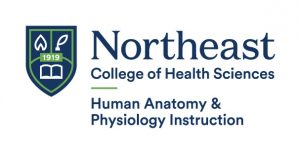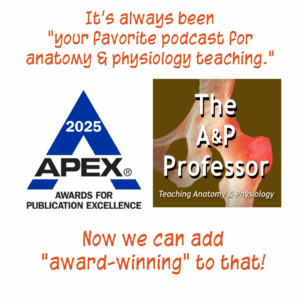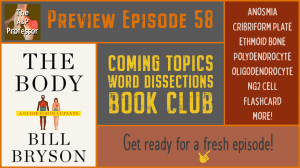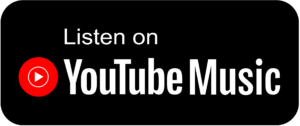Episode 58 Introduction
TAPP Radio Preview TRANSCRIPT
The A&P Professor podcast (TAPP radio) episodes are made for listening, not reading. This transcript is provided for your convenience, but hey, it’s just not possible to capture the emphasis and dramatic delivery of the audio version. Or the cool theme music. Or laughs and snorts. And because it’s generated by a combo of machine and human transcription, it may not be exactly right. So I strongly recommend listening by clicking the audio player provided.
 This searchable transcript is supported by the
This searchable transcript is supported by the
American Association for Anatomy.
I'm a member—maybe you should be one, too!
Episode 58 Intro Transcript
TAPP Radio Preview
Hi there, this is Kevin Patton with a brief audio introduction t o episode number 58 of The A&P Professor podcast. Also known as TAPP Radio. An audio thrill show for teachers of human anatomy & physiology.
In the upcoming full episode number 58 I have some science updates. One of them involves people who can smell just fine. That is, they have good olfactory perception. But when you look at their MRI it shows that they don’t have olfactory bulbs. Yeah. Weird. Right?
Another story will revisit the topic of making new neurons in the adult human brain. And if you’ve been listening to previous episodes you know that this topic comes up a lot. But this time we’re going to take it from a little bit of a different angle. We’re going to look at gene therapy for repairing brain injury.
That is, replacing neurons that are missing because of damage. And the featured topic is going to be on flashcards. Yeah, I know, everybody knows about flashcards. Everybody knows how to use flashcards, but there’s a lot of questions about flashcards.
One is, “Should we even be doing that? Shouldn’t we be teaching reasoning, and thinking skills, and not focusing on memorization?” Well, we’re going to tackle that question. Actually, there’s lots of questions to tackle when it comes to flashcards., because they have a lot of hidden powers. So, we’re going to look at the learning science behind them, and what the higher level uses of flashcards are in a multi-part series.
So, this is the first of a multi-part series on flashcards where we look at the basics, but then go way beyond the basics of using flashcards. So, there’s all that and more in the upcoming full episode number 58.
The free distribution of this podcast is sponsored by the Master of Science and Human Anatomy & Physiology Instruction. The HAPI degree. When’s the last time you had a thorough review of all the core concepts of both anatomy and physiology? Or comprehensive training in contemporary teaching practice?
Check out this online program at nycc.edu/hapi. That’s H-A-P-I. Or click the link in the show notes or episode page. There’s a new cohort forming all the time. So, best get on this soon.
Yep. It’s time once again for word dissection, and this time we have a couple of convoluted terms and some really super simple terms, but you know, it’s all about practice, practice, practice. So, we’re going to dive into this list beginning with anosmia.
A-N-O-S-M-I-A. Anosmia. And what that refers to, is a condition where you don’t have a sense of smell or you have lost the sense of smell. So, breaking that down we can see exactly that, that’s literally what the word means. The AN part at the beginning, the A-N, means without.
The O-S-M word part means smell. And then the I-A ending, we’ve seen that a lot of times in all kinds of other words, and that means a condition. So, it’s a condition without smell. Anosmia. The absence of the ability to smell. The absence of olfactory perception.
Another word on our list for dissection is cribriform plate. Now, this is a term that we use a lot, right? Because we ask our students to be able to identify it, and we’re going to be referring to it when we’re discussing the sense of smell, because the cribriform plate has all these little holes in it, it’s in the ethmoid bone, and it has all these little holes in it so that the olfactory sensory neurons can pass through.
Breaking that down, cribr word part, that is C-R-I-B-R, means seive. That is a device for separating particles by size. And you know what a seive looks like, right? It looks like the cribriform plate. It’s got a bunch of little holes in it, or big holes depending on what kind of seive you have.
The form part of cribriform means shape. So, it’s a seive shaped structure, and that makes sense, right? That’s what it looks like. So, that’s a good handy name. And if students know that, that’s what cribr means, a seive, then that’s a good mnemonic device, they can picture in their minds eye a seive and that will help them remember what it is, where it is, what it does.
And then, of course, the word plate is just an ordinary English word. We don’t need to break that down, but it’s interesting, when you go back in the history of that word, plate literally means, or originally means anything that’s flat.
The cribriform plate has this flat part that has all these little holes in it forming a seive like structure. And it’s part of the ethmoid bone, so let’s take a look at that word ethmoid. We haven’t done that before in our word dissections.
And you know what? It means kind of, the same thing. Because the ethmo part of ethmoid means seive. You know, you might think, “Well, wait a minute, I thought cribr means seive?” Well, yeah. I mean. Any language, including the English language has many different words for the same concept or idea.
Sometimes there are subtle differences in their meaning. So, it’s different aspects of whatever object is being named, but sometimes it’s just a full synonym. That is, that it just means exactly the same thing.
So, ethmo means seive, cribr means seive, and you know what? That’s okay. And then, of course, the oid end on ethmoid means like. So, if we take ethmo seive, and oid like we get a word that means seive like.
So, the ethmoid bone is seive like, because of course, a major feature of the ethmoid bone is the cribriform plate, which is a flat thing that has the shape of a seive.
So, those two words are very closely interlinked, in terms of their meaning or their translation. Another word on our list for dissection today is polydendrocyte. This term, I’m sure you can break down and figure out on your own. Poly means many. Dendro, that’s a word part that we see in a lot of terms that we commonly use in A&P. And dendro means tree.
Now, I want to stop here for a second and emphasize that literally, it means tree. But I have heard a lot of people define dendro as branch, and that’s not exactly right. It really means tree, but of course, the concept of tree involves branching, right? So, it doesn’t literally mean branch, but it implies a branched structure.
So, it’s not exactly wrong to translate it as a branch, it’s just not as literally correct, in terms of the literal translation of that word part. So, I just wanted to stop and give that aside.
And then the last part of the term polydendrocyte is cyte. C-Y-T-E. And that means cell. So, you put it all together and you have a cell that has many tree like branches. Now, that’s very similar to a term that we use much more frequently in A&P. As a matter of fact, I don’t use polydendrocyte at all in my teaching of A&P.
I’ll be honest, until I ran across a recent news item I don’t recall ever having seen that term, polydendrocyte. But I’m going to talk about them in just a few minutes and explain what they are. But it immediately reminded me of oligodendrocyte, and to me, it said, “Oh, well, it’s sort of, like an oligodendrocyte, only this one has a lot of branches.” Because oligodendrocytes, they have that word part oligo, O-L-I-G-O. Oligo. Which means few.
So, they have a few branches. They are a cell that has branches, but just a few. A polydendrocyte has branches, but many branches. So, here are two cells that are distinguished by the amount of branching that they have.
Now, polydendrocytes are also called by several other names, and a couple of the names that I’m going to mention in the news item in the full episode are NG2 cell, or NG2 glia. And when I say NG2, that’s capital letter N, capital letter G, and the arabic numeral two. NG2.
And they usually just all run together. Although, I have seen NG-2. The N part stands for the word neural. Meaning, referring to the nervous system or to nerves. The G part refers to glial, which means referring to glia. The number two refers to something that has been called antigen-2. Which is a proteoglycan. That is a protein with a bunch of glycans attached. And remember, the glycans are sugar polymers.
So, NG2 cells are cells that are part of neural tissue, and they express the proteoglycan that is sometimes called antigen-2. Now, these cells are still being figured out. There are still some things we don’t know about these cells. But what we’re fairly certainly of is, that they’re progenitor cells, that we had first thought produced oligodendrocytes.
And that is turning out to be true, but we now have evidence that they do much more than that. Or at least they’re capable of doing much more than that. And they can differentiate into astrocytes. And under the right condition they can even differentiate into neurons.
So. Polydendrocytes are progenitor cells that produce oligodendrocytes, astrocytes, neurons, and who knows? Maybe they do some other things, but the polydendrocytes, NG2 cells, they’re going to come up in one of the news stories of the full episode, in full episode number 58.
And the last word on our list is a really simple one. That is, flashcard. Which I’ve already mentioned we’re going to be talking about in the upcoming full episode. And when you break it down you get two word parts. Flash, which means flash. And card, which means card.
So, okay, that’s kind of, silly to do a word dissection like that, right? But you know, in anatomical dissection we don’t ignore the simple stuff when we do dissection, right? Because when we do the dissection sometimes there are things that we didn’t realize about that structure before actually doing the dissection.
Just talking about it, thinking about it. We didn’t realize until we actually saw it in a human body. Or an animal body. And the word flashcard is kind of, like that. Yeah, it’s a card that you use in a flash. Okay? You use them quickly. And so, it relates to one of the aspects of how we use flashcards for learning.
So, okay, you know, we haven’t learned much more by doing that, but I kind of, want to use this opportunity to go a little bit into the history of flashcards, just a little bit. We know that they’ve been used widely since the late 18th century.
They actually go back, probably to the 17th century, maybe even earlier than that. And they’re thought to have evolved from what are called hornbooks. Now, hornbooks were basically one sided flashcards that students used for learning. Often in the primary grade.
So, they would learn the letters of the alphabet, or other very basic kinds of information. And so, these hornbooks, they were basically a flashcard that was laminated with a very thin transparent sheet of animal horn.
Sometimes they used mica, which is a mineral that forms, or is found in sheets. And so, they would use that sheet of animal horn to protect the flashcard, or what we now call the flashcard. And they laminated them that way, so that they could be used by many students, over many years.
So, next time you see a laminator sitting in your faculty work room or college copy center you might, better appreciate that laminating learning materials originated with hornbooks that go way back to at least the 15th century, maybe before. Some things never change in learning.
This podcast is sponsored by HAPS. The Human Anatomy & Physiology Society. Promoting excellence in the teaching of human anatomy and physiology for over 30 years. Don’t forget, that deadline for applying for HAPS awards that help support your participation in next May’s annual conference is looming. Coming up soon. Best get on it. Just go visit HAPS at theapprofessor.org/HAPS. That’s H-A-P-S.
I have another recommendation from the A&P Professor Book Club. Actually, this recommendation comes from a listener. Marty Port. It’s a book called The Body, A Guide For Occupants. And the author is Bill Bryson.
Now, before I get to Marty’s recommendation I just want to lead off with a comment of my own. I’ve not read this book yet, but it’s been on my Kindle since it was recently released. I’m a long time reader of Bill Bryson’s books. Many of which are travel related.
Some of you know that I have a long history of educational travel. Organizing and leading college and community study tours and safaris to around two dozen countries, on five continents. So, Bryson’s travel stories then, really stimulate my travel and adventure nerves.
It turns out that Bill Bryson has a unique and entertaining voice when telling stories about his travels, which I’m guessing also apply to travels in the human body. So, I’m looking forward to a good read.
Marty Port sent me a couple of different messages about this book, which tells me that he’s really enthused about it. And I kind of, mashed them together for you here.
“Bryson is a very well known author of books for general audiences, whose written about a variety of topics including the Appalachian Trail, history, literature, among many others.”
“This book covers a large number of topics about the human body in health and disease, which are of interest to A&P Professors and students. It’s full of entertaining stories, which I have already been able to employ in my A&P one class.”
“Specifically some stories about anatomic variation and medical errors, which I was able to work into a recent class on the muscular system. For example, in the chapter called In The Dissecting Room, The Skeleton, Bryson brings up the issue of anatomic variation by stating that the palmaris longus is missing in about 14% of people.” Who knew?
He further explained that, “Since it is not all that important when present, it’s used by surgeons as a source for tendon grafting. I happened to be reading about the palmaris longus, about the time I’d listened to your podcast on anatomic variations.”
“To this point, I had never bothered to mention anatomic variations. So, in the middle of discussing the muscles of the anterior forearm I mentioned the palmaris longus and went into the issue of variations.”
“Since I was on a variations roll, I mentioned situs inversus, which was featured in your podcast, and the fact that it was rare. Occurring in about one in 10 thousand people.”
“And guess what? One of the students raised her hand and announced that her brother has situs inversus. What were the odds? Oh, right, one in 10 thousand. That 15 minute segment of lab class was a lot more interesting to the students, and to me, than any other 15 minute segment all semester.”
“Bryson’s book is chock full of facts just like this. I discovered your podcast and HAPS a couple of months ago, and caught up on all the podcasts. There’s a significant degree of synergy between your information and the entertaining stories in Bryson’s book.”
“It would be a good fit for the book club.” Well, thanks a lot, Marty. I really appreciate the time and effort you took to share this with us. Especially the specific ways in which it helped in your teaching. That’s super.
Now, I’m looking forward to reading this book even more. I’ll be a better storyteller for listening to Bryson’s storytelling about the human body.
Hey, let’s make this a regular book club, okay? First we need to get out a glass of wine or a cup of tea, and then find a comfy chair near a fireplace, and tell the rest of us what you think of this book. Or any book from the A&P Professor book club.
Just call or write in, and I’ll share your comments on this podcast. Well, depending on how much wine you’ve had before you make your call. A searchable transcript and a captioned audiogram of this preview episode are funded by AAA. The American Association For Anatomy at anatomy.org.
Speaking of anatomy.org, they’re just now launching the new and improved version of the website, which is helping us find all the resources, even more easily than before.
It’s part of the rebranding project that’s already given us a new name, and a new logo for AAA. Go check it out. That’s anatomy.org. Well, this is Kevin Patton signing off for now, and reminding you to keep your questions and comments coming.
Why not call the podcast hotline right now at 1-833-LION-DEN. That’s 1-833-546-6336. Or visit us at theapprofessor.org. I’ll see you down the road.
This podcast is sponsored by the
Human Anatomy & Physiology Society 
This podcast is sponsored by the
Master of Science in
Human Anatomy & Physiology Instruction 

Stay Connected
The easiest way to keep up with new episodes is, um, wherever you already listen to audio!
Click here to be notified by email when new episodes become available (make sure The A&P Professor option is checked).
Call in
Record your question or share an idea and I may use it in a future podcast!
Toll-free: 1·833·LION·DEN (1·833·546·6336)
Email: podcast@theAPprofessor.org
Share

Tools & Resources
TAPP Science & Education Updates (free)
TextExpander (paste snippets)
Krisp Free Noise-Cancelling App
Snagit & Camtasia (media tools)
Rev.com ($10 off transcriptions, captions)
The A&P Professor Logo Items
(Compensation may be received)
🏅 NOTE: TAPP ed badges and certificates can be claimed until the end of 2025. After that, they remain valid, but no additional credentials can be claimed. This results from the free tier of Canvas Credentials shutting down (and lowest paid tier is far, far away from a cost-effective rate for our level of usage). For more information, visit TAPP ed at theAPprofessor.org/education







